The Hoa Lu Historic and Cultural Site is a journey into the very roots of Vietnamese heritage, architecture, and cultural poetry. For travelers seeking not just to visit but to understand, Hoa Lu offers the perfect blend of history, scenic landscapes, and the architectural marvels of ancient Vietnam. Here, with Pioneer Sail Travel, you can explore Hoa Lu in depth—from the legacy of the Dinh and Le dynasties to the peaceful beauty of its limestone mountains, temples, and pagodas.
Hoa Lu’s Cultural Legacy: Vietnam’s First Capital
Known as Vietnam’s first capital in the 10th and early 11th centuries, Hoa Lu is a place steeped in history and pride. The Hoa Lu Historic and Cultural Site showcases remnants of an era when Vietnamese identity was being shaped, both politically and culturally. It’s a location that has inspired generations, with its storied monuments, natural settings, and folklore.

The Historical Significance of Hoa Lu and Its Monuments
Established by Emperor Dinh Tien Hoang, Hoa Lu was strategically chosen for its natural defenses—the surrounding limestone mountains offered protection and a powerful symbol of the region’s strength. Emperor Le Dai Hanh succeeded Dinh, continuing Hoa Lu’s development as a cultural center. Today, Hoa Lu Historic and Cultural Monuments like the Dinh and Le Temples serve as living memories of this era, preserved as testaments to the resilience and artistry of ancient Vietnam.
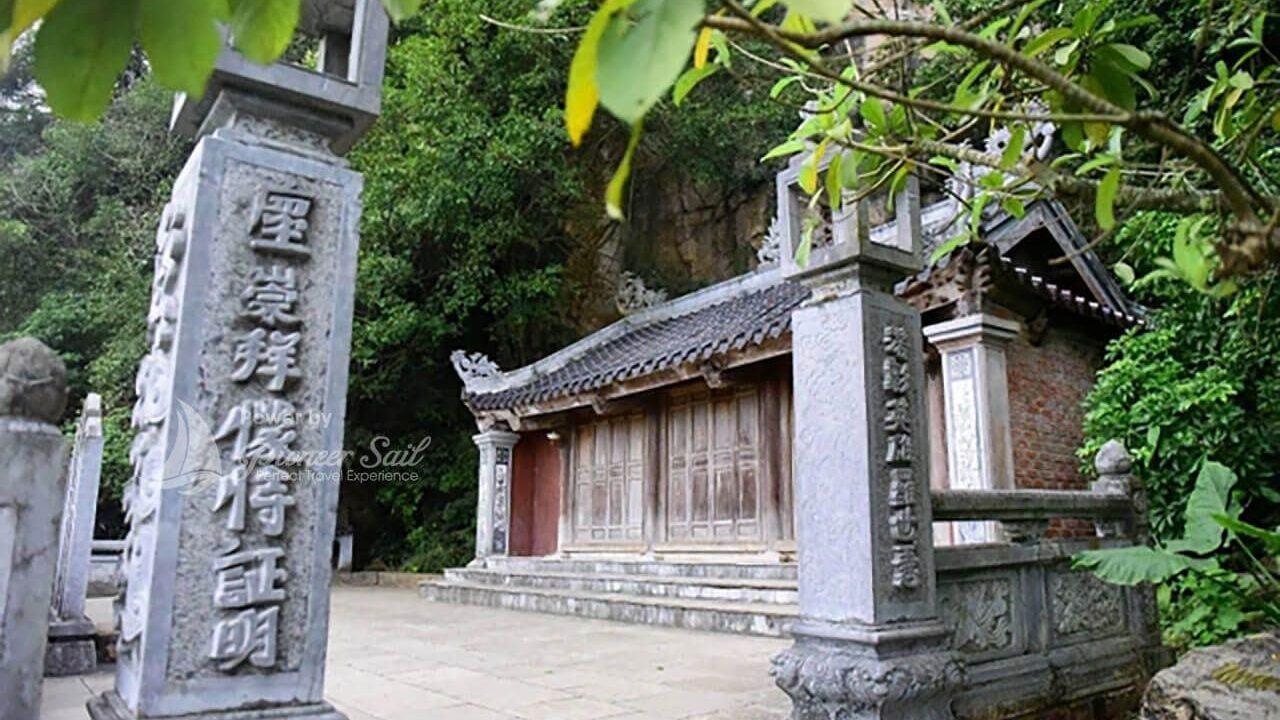
- Dinh Temple: Dedicated to Emperor Dinh Tien Hoang, this temple is an architectural masterpiece that reflects the power and spiritual beliefs of its time. Inside, the altars feature statues and offerings, where visitors can observe traditional Vietnamese designs, dragon motifs, and complex wood carvings. The Dinh Temple has inspired visitors with its solemn atmosphere and meticulously preserved relics.
- Le Temple: A short distance away, Le Temple is dedicated to Emperor Le Dai Hanh, whose rule reinforced Vietnamese independence and identity. Surrounded by gardens and peaceful courtyards, the temple offers a quieter experience, allowing visitors to connect deeply with the stories of the past. Like Dinh Temple, Le Temple reflects traditional Vietnamese design through its altars, sculptures, and intricate detailing.
Local Insight: In 2014, UNESCO recognized Hoa Lu as part of the Trang An Landscape Complex, a testament to its historical and cultural importance. This acknowledgment has amplified its status, drawing cultural seekers and historians alike to its sacred grounds.
The Artistic Soul of Hoa Lu’s Architecture
Vietnam’s traditional aesthetics are on full display at the Hoa Lu Historic and Cultural Site. From its gates to stone steles, Hoa Lu’s architecture showcases a rich blend of artistic expression rooted in symbolism, color, and materials. Vietnamese architecture during this period relied heavily on natural materials like wood, stone, and lacquer, which were used not just for their beauty but for their cultural and spiritual significance.
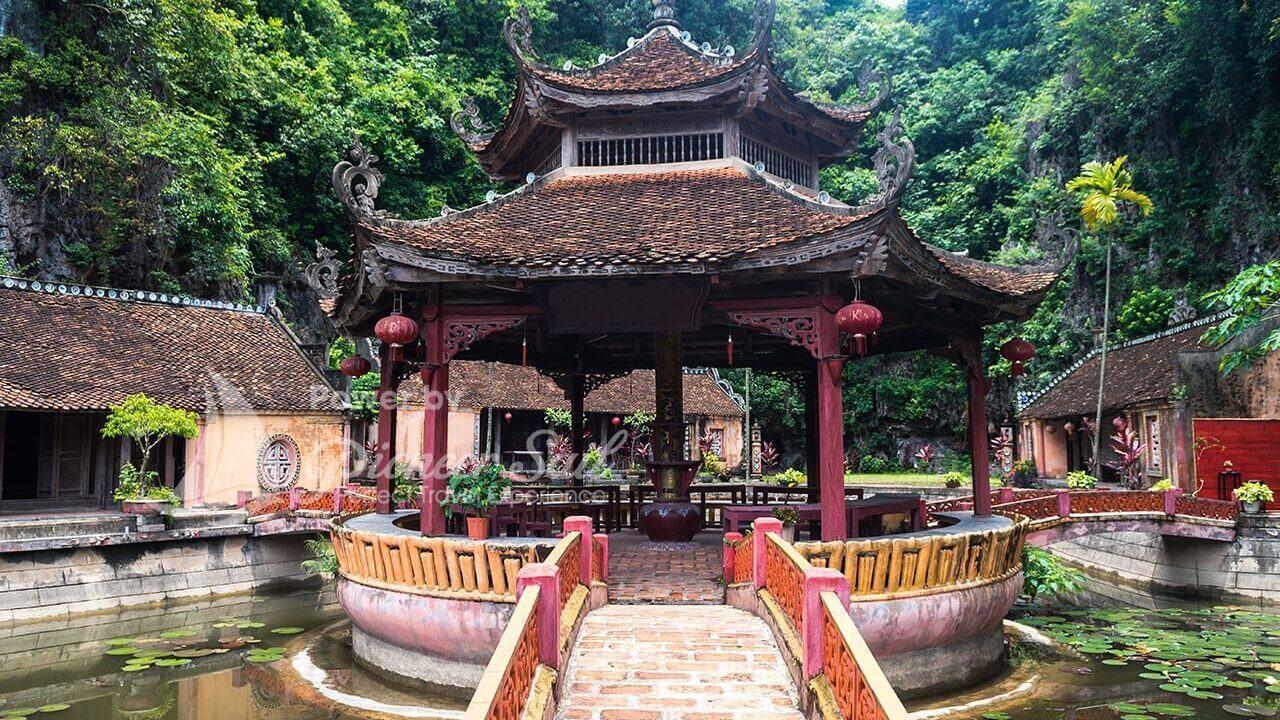
- Craftsmanship and Materials: The stonework and wood carvings found at Hoa Lu represent some of the finest examples of Vietnamese craftsmanship. Stones carved with intricate details depict dragons, phoenixes, and lotus flowers—symbols of power, resilience, and purity in Vietnamese culture. Lacquer and gold leaf on altars add a sense of reverence and beauty, designed to honor the emperors and ancestors.
- Symbolism in Colors: Red, black, and gold are prominent colors within the temples and monuments of Hoa Lu. Red, often associated with power and prosperity, can be found in the lacquer of altars and doors. Gold represents divine power and the authority of the emperor, while black symbolizes stability and longevity. Each color used in Hoa Lu’s architecture holds meaning, inviting visitors to look deeper into the beliefs of ancient Vietnam.
Artistic Reflection: Traditional Vietnamese architecture often includes low-hanging, curved roofs—said to resemble the wings of a bird in flight. This design symbolizes protection and freedom, reinforcing the connection between people and nature that defines much of Vietnamese culture.
For travelers drawn to the beauty of history, Hoa Lu’s temples and landscapes offer a perfect setting to explore Vietnamese heritage with intention and wonder.
Experiencing Hoa Lu: A Journey Through Time and Space
To truly capture the spirit of the Hoa Lu Historic and Cultural Site, travelers can take a thoughtfully paced approach, allowing time to appreciate each architectural marvel, natural vista, and historical landmark. This itinerary provides a way to immerse in the legacy of Vietnam’s first capital, experiencing the area’s beauty and significance in a meaningful way.
Morning Reflection: Temples and Monuments
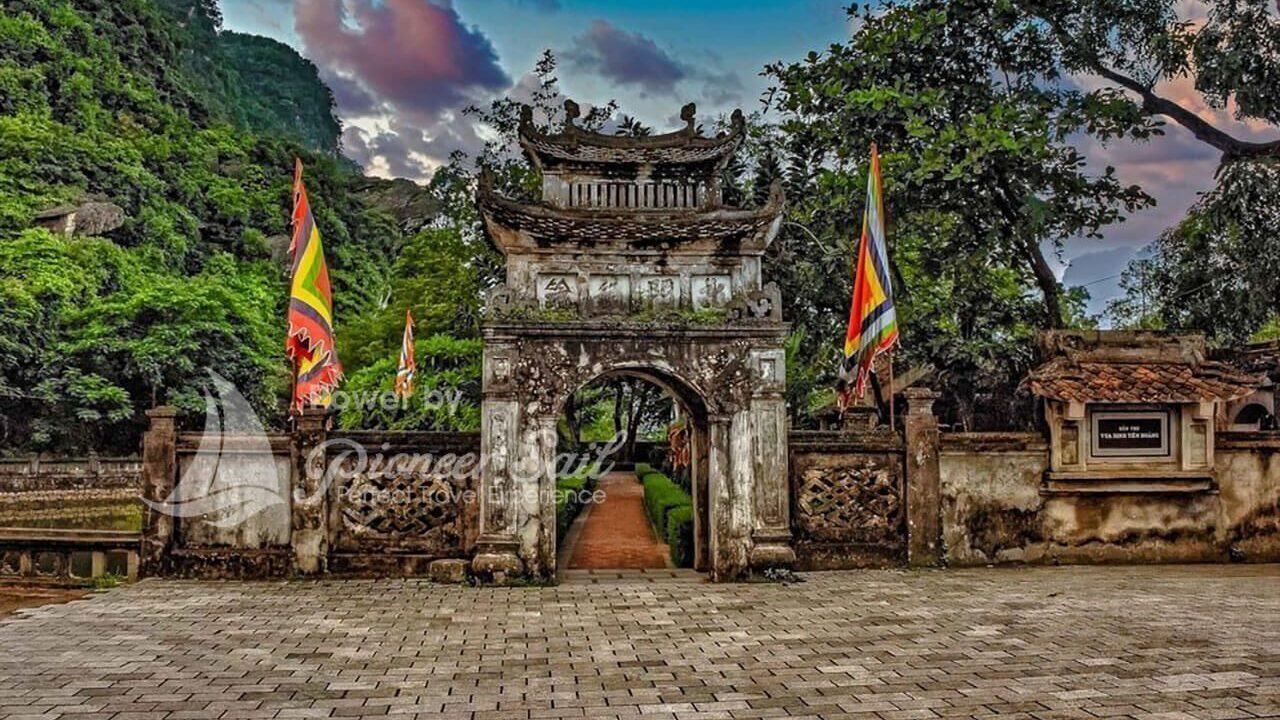
Starting your day early at Hoa Lu ensures a peaceful, immersive experience. The morning light casts a gentle glow over the temples and landscapes, creating a serene atmosphere.
- Dinh and Le Temples: Begin with a visit to the Dinh and Le Temples. As you explore these structures, take time to notice the intricate wood carvings depicting mythical creatures and lotus flowers, symbolizing prosperity and purity. The temples were constructed with materials chosen carefully for their endurance and symbolic value, such as lacquered wood and polished stone. Walking through the temple courtyards, you may feel a sense of reverence for the emperors who once walked these grounds.
- Stone Steles and Gates: Outside the temples, you’ll find stone steles bearing historical inscriptions. These steles serve as silent witnesses to Vietnam’s dynastic eras and are a window into the nation’s history, documenting significant events and the lives of past rulers. The ancient stone gates are another highlight; with their curved arches and weathered surfaces, they stand as guardians of this historical site.
Reflective Tip: Take a moment to stand by the gates and steles, reflecting on how they’ve endured for over a millennium. Imagining the stories of the countless visitors who have passed through these gates can deepen your connection to Hoa Lu’s heritage.
Midday Discovery: Hoa Lu’s Landscape and Caves
As the morning progresses, venture beyond the temples to Hoa Lu’s natural landscapes. The limestone cliffs and cave systems around Hoa Lu are not only visually stunning but also hold cultural significance, having inspired Vietnamese poetry, legends, and folklore for centuries.
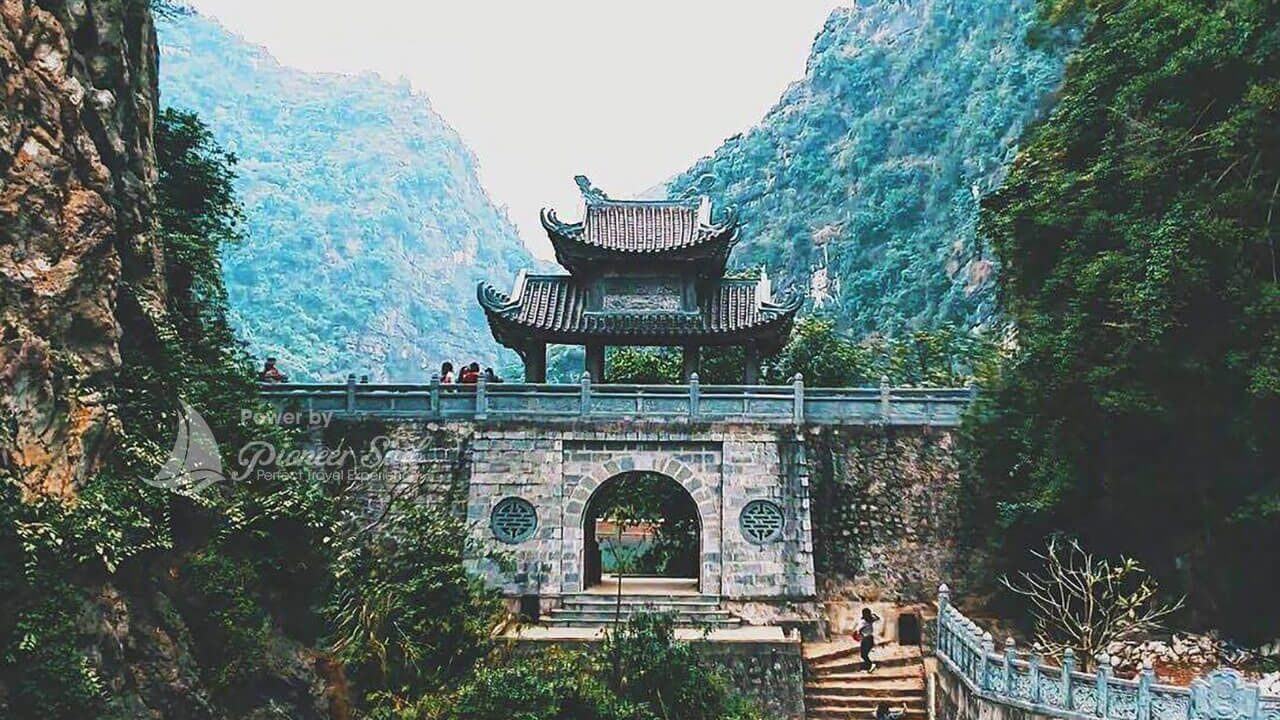
- Limestone Cliffs and Valleys: The dramatic limestone formations surrounding Hoa Lu were seen as protectors of the ancient capital. The locals believed that these natural “walls” safeguarded Hoa Lu from invaders. These cliffs are often referenced in Vietnamese literature and poems, celebrated for their majesty and strength. As you walk through the valleys, you’ll see how nature and history intertwine, forming a landscape that feels timeless and untouched.
- Am Tien Cave: Known as “Bich Dong’s Heaven,” Am Tien Cave is a serene location perfect for contemplation. This cave, set in the middle of a clear lake and surrounded by limestone walls, offers an ideal setting to take in the scenery quietly. Am Tien is also tied to local folklore and was used as a place of meditation and retreat by ancient monks.
Cultural Insight: Many legends and poems mention caves and limestone mountains as sacred places where monks, warriors, and emperors found solitude. Visiting Am Tien Cave gives you a glimpse into the introspective side of Vietnamese culture, where nature serves as a spiritual retreat.
Evening Contemplation: Bich Dong Pagoda and Traditional Dishes
Conclude your day with a visit to Bich Dong Pagoda. Built into the mountainside, this pagoda is one of Vietnam’s most scenic temples, with its three structures—the Lower, Middle, and Upper pagodas—each offering a unique perspective over the valley.
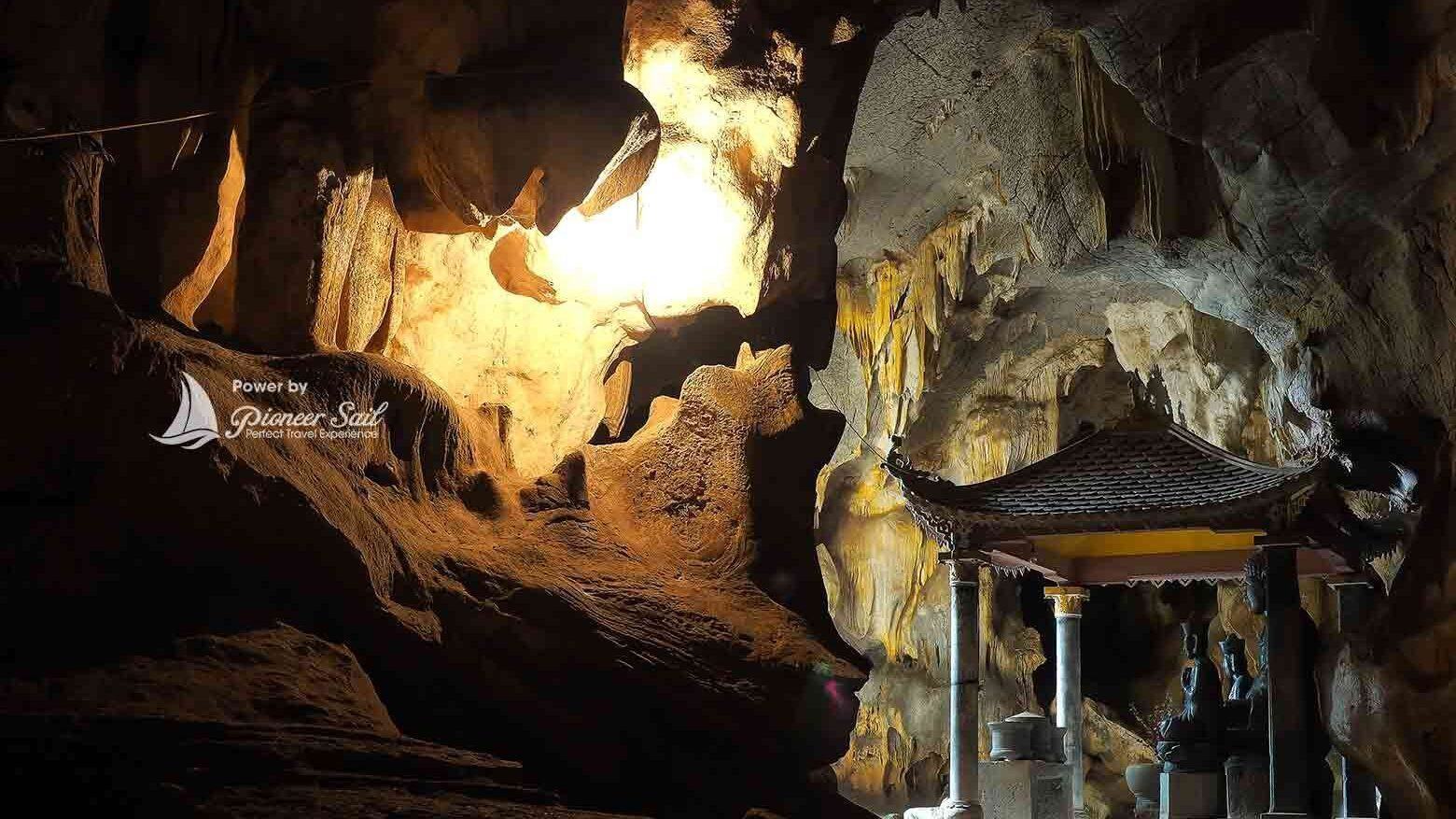
- Bich Dong Pagoda: As you ascend the stone steps leading to each pagoda, you’ll notice the shift from an earthly to a spiritual atmosphere. The architectural simplicity of the pagodas, combined with their integration into the natural rock, creates a peaceful setting ideal for meditation and reflection. At the top, the view is breathtaking, especially as the sun begins to set over the landscape, casting a warm glow on the limestone peaks.
- Local Cuisine: After visiting Bich Dong, enjoy a traditional Vietnamese dinner at one of the nearby eateries. Hoa Lu is known for its rustic dishes, including “com chay” (crispy rice) and goat meat specialties unique to the Ninh Binh region. This culinary experience adds a flavorful ending to a day spent exploring history and heritage.
Dining Insight: The local dishes are deeply connected to Hoa Lu’s agricultural landscape. Trying regional foods lets you taste a piece of the culture and connect with the flavors that have sustained the people here for centuries.
The Materials, Craftsmanship, and Colors of Hoa Lu
Exploring Hoa Lu’s architecture provides a window into the craftsmanship and symbolism of ancient Vietnamese artisans. The materials, designs, and colors used throughout Hoa Lu’s monuments reflect the values and beliefs of the time, adding layers of meaning to each structure.
Woodwork, Stone Carvings, and Lacquer in Ancient Architecture
Hoa Lu’s ancient structures are a testament to the skills of Vietnamese craftsmen who worked with natural materials to create lasting beauty. Wood, a primary material in temple architecture, is carved with intricate details depicting mythical creatures, floral patterns, and symbols of longevity and prosperity. Each carving represents a cultural belief, from the dragon’s power to the lotus flower’s purity.
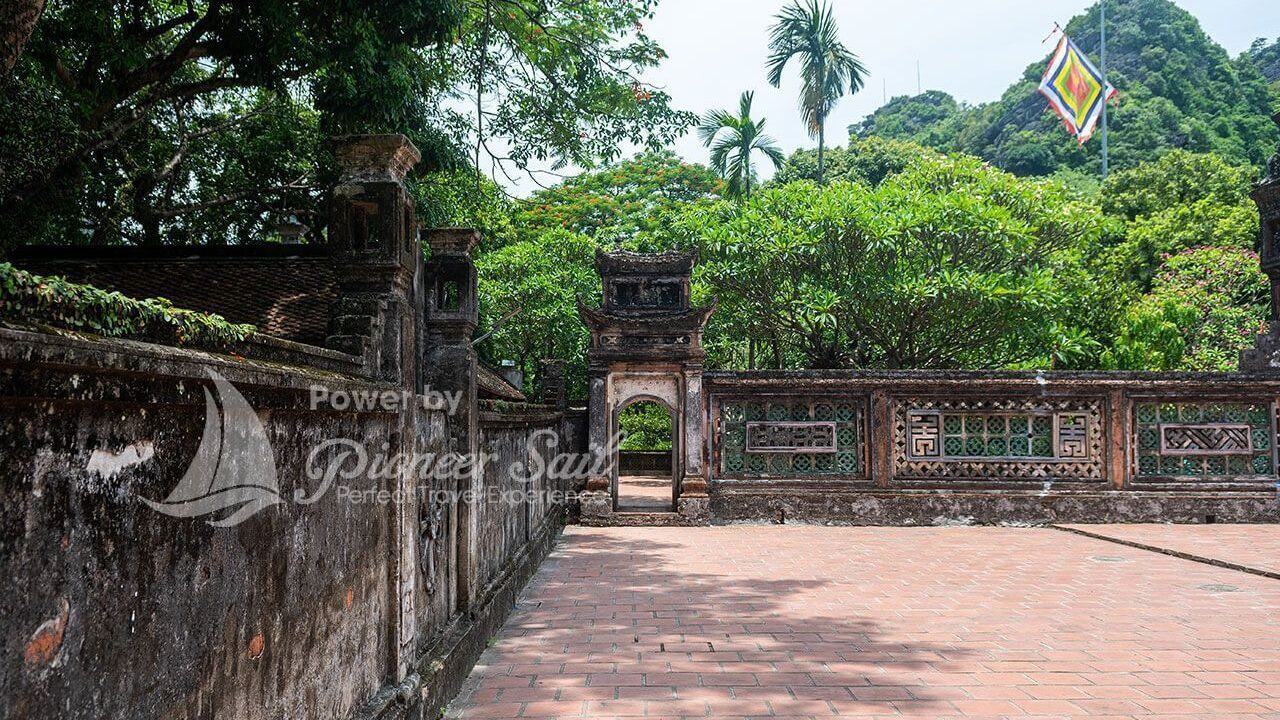
- Stone Steles and Sculptures: The stone steles found throughout Hoa Lu are engraved with stories of emperors and local heroes. These inscriptions, etched into hard rock, show the resilience of these tales and the commitment to preserving history for future generations. The stone guardians at the temple entrances, often lions or mythical creatures, serve both decorative and protective functions, embodying the strength and power associated with the emperors.
- Lacquer and Gold Leaf: Vietnamese temples traditionally use lacquer and gold leaf on altars and important statues. The use of gold leaf symbolizes divine power and reverence, while lacquer protects the wood, ensuring that the structures remain beautiful for centuries.
Craftsmanship Tip: Notice the details in the wood carvings and the textures of the stone steles. Each tells a story not only of the people it honors but of the hands that crafted it—Vietnamese artisans who embedded their beliefs and values into every stroke.
Symbolism and Color in Hoa Lu’s Structures
Colors hold powerful symbolism within Vietnamese culture, and this symbolism is evident throughout the Hoa Lu Historic and Cultural Site. Each color serves to enhance the spiritual aura of the place, adding layers of meaning that visitors can appreciate.
- Red: Commonly used in temples, red represents prosperity, luck, and the lifeblood of the people. You’ll find red lacquer on many altars, doors, and columns, inviting good fortune and honoring ancestors.
- Gold: As the color of royalty, gold is prominent in altars and statues dedicated to emperors and gods. Its sheen symbolizes both divine and earthly power, and the use of gold in Hoa Lu emphasizes the reverence held for the figures enshrined here.
- Black and Earth Tones: Representing stability, black is often found in the structural elements of temples, symbolizing resilience. Earth tones, like the natural hues of stone and wood, serve to connect the temples with their surroundings, making each structure feel like an extension of the natural landscape.
Color Reflection: When exploring Hoa Lu’s temples, observe how these colors are not just aesthetic choices but cultural expressions. They remind visitors of the harmony between the material and spiritual, the natural and the divine.
Hoa Lu in Poetry and Folklore: A Cultural Legacy
The landscapes and history of Hoa Lu have inspired countless poems, proverbs, and folk stories over the centuries. The beauty of Hoa Lu is not only seen but felt, reflected in Vietnamese literature that captures the spirit of this ancient capital.
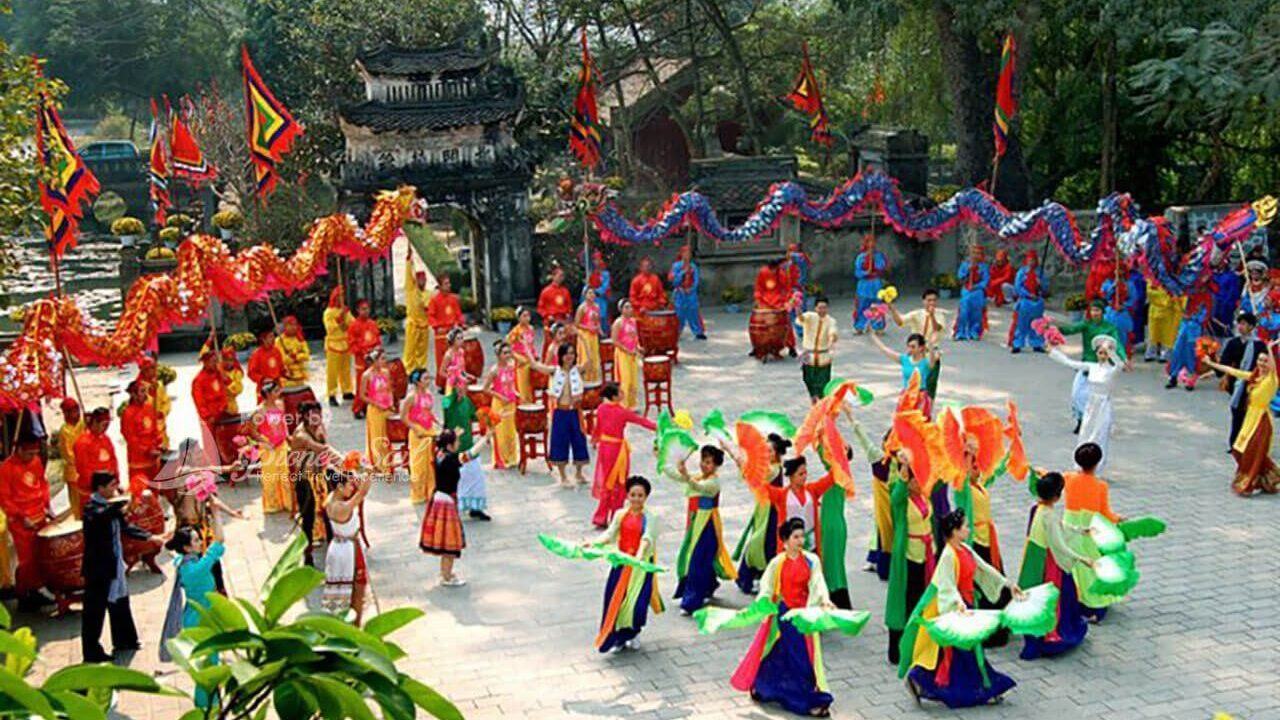
Folklore and Stories from the Dinh and Le Dynasties
Legends surrounding Hoa Lu often highlight the bravery and wisdom of the emperors who ruled here. Tales of Emperor Dinh Tien Hoang’s military strategies and Emperor Le Dai Hanh’s diplomacy are celebrated in Vietnamese folklore, emphasizing the values of courage, loyalty, and wisdom. Many local guides share these stories with visitors, enriching the experience with narratives that bring the past to life.
Poetic Inspirations from Hoa Lu’s Landscapes
Hoa Lu’s dramatic landscapes have long been a source of inspiration for Vietnamese poets. The region’s misty mountains, tranquil rivers, and reflective lakes are often likened to scenes of a painting, inspiring verses that capture its serene beauty. Vietnamese poets have described Hoa Lu as a place where heaven meets earth, a land where nature and history coexist in harmony.
Literary Tip: Consider reading a Vietnamese poem inspired by Hoa Lu or asking a guide to share a few verses. It’s a powerful way to connect with the cultural appreciation locals have for their homeland.
Conclusion: Why the Hoa Lu Historic and Cultural Site is a Must-Visit for Cultural Seekers
The Hoa Lu Historic and Cultural Site is more than a destination; it’s an invitation to step into a world where history, architecture, and culture converge. From the rich symbolism in its temples and colors to the timeless stories told by its landscapes, Hoa Lu offers visitors a deeply fulfilling experience that goes beyond sightseeing. With Pioneer Sail Travel, your journey through Hoa Lu becomes an exploration of Vietnamese heritage, inspiring reflection, wonder, and a lasting appreciation for the resilience and beauty of this ancient capital.
FAQs
What are the primary cultural highlights of the Hoa Lu Historic and Cultural Site?
Key highlights include the Dinh and Le Temples, ancient gates, and stone steles that showcase Vietnamese craftsmanship and cultural heritage.
What architectural styles define Hoa Lu’s temples and structures?
Hoa Lu’s architecture combines wood, stone, and lacquer with traditional motifs such as dragons and lotus flowers, embodying the artistry of ancient Vietnam.
How does Hoa Lu’s history reflect in local Vietnamese poetry and folklore?
Many Vietnamese poems and folk stories celebrate Hoa Lu’s landscapes and heroic rulers, reflecting the region’s enduring cultural significance.
What materials and colors are commonly used in Hoa Lu’s historic structures?
Common materials include stone, wood, and lacquer, with colors like red, gold, and black symbolizing prosperity, divinity, and resilience.
What is the best way to experience Hoa Lu’s landscapes and monuments?
For a meaningful experience, start with the temples in the morning, explore the caves and landscapes midday, and end with sunset at Bich Dong Pagoda.
tags:
hoa lu historic and cultural site, hoa lu historic and cultural monument, hoa lu historic and cultural landmarks, vietnam cultural tours, hoa lu ancient capital, vietnam heritage sites, hoa lu travel, hoa lu architecture, hoa lu poetry






